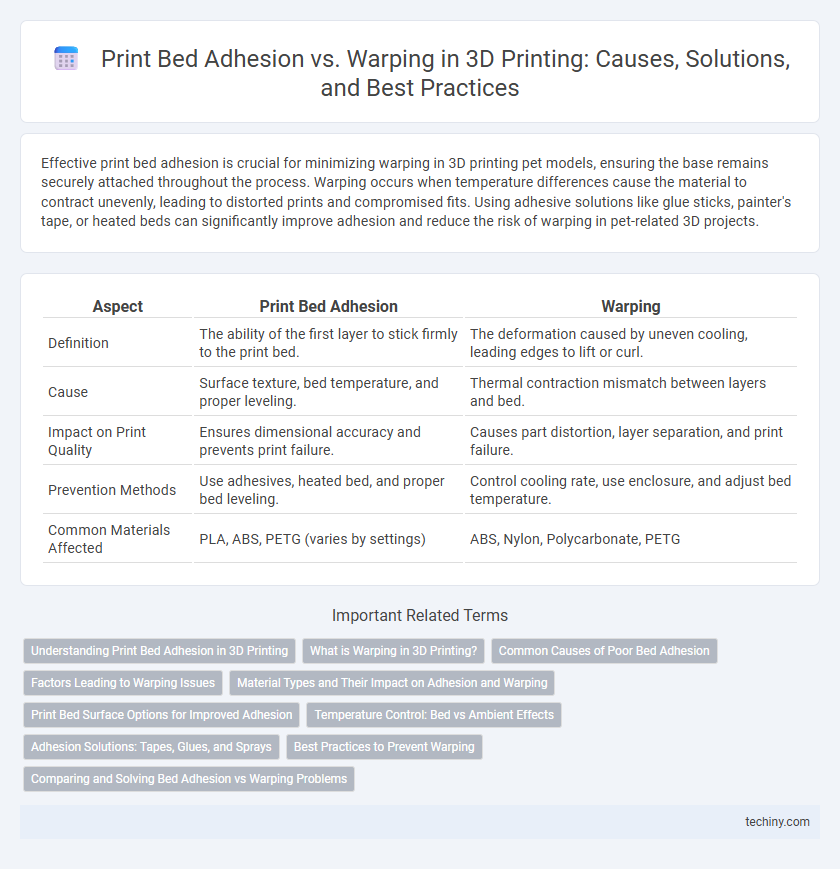Effective print bed adhesion is crucial for minimizing warping in 3D printing pet models, ensuring the base remains securely attached throughout the process. Warping occurs when temperature differences cause the material to contract unevenly, leading to distorted prints and compromised fits. Using adhesive solutions like glue sticks, painter's tape, or heated beds can significantly improve adhesion and reduce the risk of warping in pet-related 3D projects.
Table of Comparison
| Aspect | Print Bed Adhesion | Warping |
|---|---|---|
| Definition | The ability of the first layer to stick firmly to the print bed. | The deformation caused by uneven cooling, leading edges to lift or curl. |
| Cause | Surface texture, bed temperature, and proper leveling. | Thermal contraction mismatch between layers and bed. |
| Impact on Print Quality | Ensures dimensional accuracy and prevents print failure. | Causes part distortion, layer separation, and print failure. |
| Prevention Methods | Use adhesives, heated bed, and proper bed leveling. | Control cooling rate, use enclosure, and adjust bed temperature. |
| Common Materials Affected | PLA, ABS, PETG (varies by settings) | ABS, Nylon, Polycarbonate, PETG |
Understanding Print Bed Adhesion in 3D Printing
Print bed adhesion is crucial for minimizing warping in 3D printing, ensuring the first layer firmly sticks to the build surface to prevent edge curling or deformation. Techniques such as applying adhesive sprays, using heated beds, or selecting compatible build surface materials optimize adhesion by promoting uniform thermal contraction. Understanding the interaction between filament type, bed temperature, and surface texture directly impacts print quality and reduces failed prints caused by warping.
What is Warping in 3D Printing?
Warping in 3D printing occurs when the corners or edges of a printed object lift and curl away from the print bed due to uneven cooling and contraction of the material. This defect compromises dimensional accuracy and structural integrity, often caused by insufficient bed adhesion or improper temperature settings. Ensuring optimal print bed adhesion through heated beds, adhesive sprays, or textured surfaces minimizes warping by maintaining consistent contact during the cooling process.
Common Causes of Poor Bed Adhesion
Poor bed adhesion in 3D printing commonly results from an unlevel print bed, incorrect nozzle distance, and inappropriate print surface materials. Insufficient bed temperature and contaminated surfaces, such as dust or oils, further reduce filament bonding. These factors increase the risk of warping by causing uneven cooling and detachment during the printing process.
Factors Leading to Warping Issues
Warping in 3D printing primarily occurs due to uneven cooling and contraction of the printed material, which reduces print bed adhesion and causes corners or edges to lift from the bed. Key factors leading to warping include insufficient bed temperature, lack of proper surface preparation, and rapid cooling of filament, especially with materials like ABS and Nylon that have higher thermal contraction rates. Optimizing bed temperature, using adhesives such as glue stick or PEI sheets, and controlling ambient temperature through enclosures significantly improve adhesion and minimize warping defects.
Material Types and Their Impact on Adhesion and Warping
Material types like PLA, ABS, and PETG significantly influence print bed adhesion and warping in 3D printing. PLA typically offers excellent adhesion with minimal warping due to its low shrinkage, making it ideal for detailed prints on standard build surfaces. In contrast, ABS and PETG require heated beds and specialized adhesion aids like glue sticks or PEI sheets to counteract their higher shrinkage and tendency to warp during cooling.
Print Bed Surface Options for Improved Adhesion
Selecting the right print bed surface significantly enhances print bed adhesion, reducing the risk of warping during 3D printing. Surfaces such as PEI sheets, BuildTak, and glass with adhesive sprays or tapes provide varying levels of grip tailored to materials like PLA, ABS, and PETG. Combining an optimal surface with proper temperature settings creates a stable base, minimizing shrinkage and deformation in printed parts.
Temperature Control: Bed vs Ambient Effects
Effective temperature control significantly impacts print bed adhesion and the reduction of warping in 3D printing. Maintaining a heated bed temperature around 60-110degC stabilizes the first layer adhesion by preventing premature cooling and contraction of the filament. Controlling ambient temperature within the enclosure minimizes thermal gradients, thereby reducing internal stresses and warping during the printing process.
Adhesion Solutions: Tapes, Glues, and Sprays
Effective print bed adhesion is crucial to prevent warping in 3D printing, ensuring the first layers remain securely attached during the process. Common adhesion solutions include painter's tape, PVA glue sticks, and specialized adhesive sprays, each tailored to different filament types and bed surfaces. Proper application of these adhesives enhances layer bonding, reducing print failures and improving overall surface quality.
Best Practices to Prevent Warping
Optimal print bed adhesion is crucial for minimizing warping in 3D printing, as poor adhesion causes filament edges to lift and deform. Techniques such as using heated beds, applying adhesive surfaces like glue sticks or painter's tape, and calibrating bed leveling improve the bond between the print and the bed. Controlling environmental factors like ambient temperature and using enclosures further stabilize prints, reducing internal stresses that lead to warping.
Comparing and Solving Bed Adhesion vs Warping Problems
Print bed adhesion and warping are critical factors influencing 3D print quality, where poor bed adhesion often leads to part lifting, while warping results from uneven cooling and material contraction. Optimizing bed surface materials like PEI sheets or applying adhesives such as glue sticks enhances initial layer bonding, reducing lift-off and minimizing warping tendencies. Heated beds set to appropriate temperatures for specific filaments, combined with controlled ambient cooling via enclosures, significantly mitigate warping while improving overall print stability.
Print bed adhesion vs Warping Infographic

 techiny.com
techiny.com